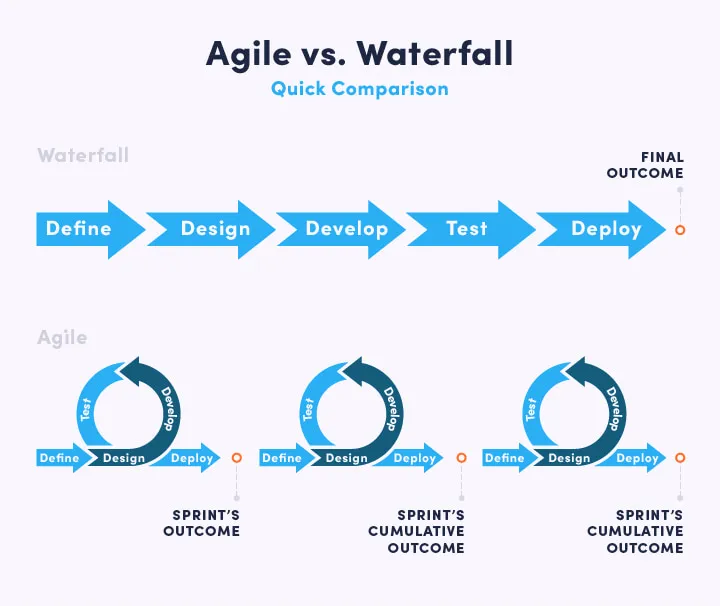Software Development Companies are witnessing great success in satisfying client needs by adapting Agile Software development methodology. It is a method that offers an iterative approach to design and software development.
It comes as no surprise that technology changes every second. The Agile approach helps organizations embrace these changes in the development field by allowing team members to break down lengthy procedures into small segments to build and test software. It enables the development team to deliver work quickly and more frequently.
According to the State of Agile Report 2020, 95% out of 4000 respondents prefer Agile development. The methodology promotes cross-functional teams across the organization, which helps speed up the entire development process.
This article will discuss the Agile development methodology and other Agile methodologies and you will also learn:
- What are the key benefits of adopting Agile methodology over traditional Waterfall methods in software development?
- How does Agile project management foster better communication and collaboration within a team?
- In the Agile approach, what is the role of the Product Owner and how does it differ from traditional project management roles?
- How do Kanban boards aid in visualising workflow and prioritising tasks within an Agile team?
- What are the responsibilities of a Scrum Master, and how do they facilitate the project's progress?
- How does Agile methodology allow for backward tracking and the addition of new features during the software development process?
So, let's start.
What is Agile Methodology?
The Agile Methodology is an advanced approach to developing software with flexibility and speed. The methodology has introduced new concepts of iterative and incremental development methods to ensure foolproof and accelerated delivery.
Traditional methods like Waterfall used to dominate the industry, but not anymore. The reason for Waterfall methods to start fading is the absence of no backward movement. There is no room for adding new features, and maintenance is also very challenging.
Mike Cohn, the Contributor of the Scrum Software Development Method, said:
The worst thing you can deliver in a two-year project is what the customer wanted on day one.
The Agile methodology of software development allows backward tracking and enables the development team to build a broader feature set in time-boxed cycles.
It follows a typical development process from requirement gatherings to design, development, testing, deployment, and maintenance. However, the strategy in the Agile methodology changes at each stage.
What is Agile project management all about?
Agile project management is a flexible and interactive approach that emphasizes collaboration and adaptability. It involves breaking down the project into smaller tasks called "sprints", which are short, time-boxed periods of work. Agile project management encourages regular communication and a feedback loop among team members, stakeholders and customers. It promotes transparency by using visual tools like Kanban boards to track progress and prioritize tasks. By embracing change and continuous improvement, agile project management empowers teams to deliver high-quality results efficiently and respond effectively to evolving project requirements.
If you are interested in the future of agile, you will learn more from this article about: the future of agile project management. You will also know agile decision making techniques.
Try our developers.
Free for 2 weeks.
No risk. Just results. Get a feel for our process, speed, and quality — work with our developers for a trial sprint and see why global companies choose Selleo.
Agile vs. Waterfall: Quick Comparison
Many development companies are moving towards Agile processes and moving away from the predictive, Waterfall methodology when developing software. By embracing agile project management, companies can enhance their development practices and optimize the software development lifecycle.

Conventional Waterfall Methodology
The conventional Waterfall development method involves strict phases. An Agile software dev is supposed to stick to the original design plan created at the beginning of the project. In a Waterfall approach to development, the project manager spends a lot of time negotiating milestones, allocating resources, features, and working at length in a project's planning stage.
The customer finalizes the requirements before the development process begins. It takes a lengthy development process where the project manager tracks every project's movement throughout the delivery. In such an approach, the biggest drawbacks are that the software is not responsive to change, and the process took too long to deliver working software. When software is ready to use and drives every change, a six-month (or longer) release cycle, with requirements chiselled in stone, does not meet the business's need.
The Agile Methodology
The frustration developed in the traditional Waterfall method gave birth to the Agile software development methodology. The Agile software development methodology is based on the concept of catering to changes and a faster process of software development. Project management also plays a huge role in Agile, as project managers take part in planning, executing, monitoring, controlling and closing projects. The Agile methodology doesn't base on milestones. It is based on hours, feature selection, prioritization, and meeting the client's requirements.
The Agile development processes are divided into sprints or iterations. At the beginning of each iteration or Sprint, the development team decides what can be accomplished within this time frame and what sets of features will be delivered. At the end of each Sprint, the software is placed in a production environment so the client can take a look and provide their feedback.
Now, let’s look at the roles, responsibilities and other agile manifestos in an Agile Methodology.
Read also: How To Build High-Performance Agile Teams
Roles & Responsibilities in Agile Software
The Agile software development life-cycle (SDLC) is developed with a clear goal of rapid delivery of the software through an incremental and iterative process designed to adapt and improve software quality from the client's perspective.
Agile teams are comprised of the following key roles and responsibilities:

Product Owner
The Product Owner represents the Stakeholder of the project. He/she understands the project from the Stakeholder's perspective. The crucial role of a Product Owner is to set the direction for product development or project progress.
Key Responsibilities for Product Owner:
- Product backlog management
- Release management
- Stakeholder management
Team Lead or Scrum Master
The Team Lead or the Scrum Master is the main bridge between the team members and the Product Owner. The Team Lead / Scrum Master takes instructions from the Product Owner and supports the project's progress among individual team members.
Key Responsibilities for Team Lead/Scrum Master
- Arranging and managing the daily Scrum and Sprint initiatives
- Coordinating between team members about changing requirements
- Motivating team members for delivering results
- Managing tasks such as conducting meetings, facilitating collaboration, and eliminating hurdles affecting project progress
- Keeping team members protected from external interferences and distractions
This role also plays extra responsibilities, such as:
- Implementing changes
- Coordinating between stakeholders to find necessary resources
- Helping Product Owners optimize the backlog planning for maximum performance
Development Team Members
Team members within the Development Team comprise experienced individuals who are directly or indirectly linked to product development. The team is a combination of different roles responsible for taking an idea or requirements and transforming it into a tangible product for end-users.
Key Roles of Team Members
- Product designer
- Programmer
- Tester
- UX/UI specialist
Key Responsibility for Development Team
- Delivering the work throughout the Sprints according to the Product Owner's requirements,
- Taking items from Product Backlog to the Sprint Backlog and committing to delivering the value during the Sprint,
- Self-organizing in order to fulfil their tasks.
Stakeholders
The Stakeholders may not be directly involved in the development process, but they play key roles, and their decision can impact the Scrum team's work. A stakeholder can be:
- The end-user of the product (Client)
- Business Executives (Employees of the company for whom the Software is under development)
- Production Support staff (Testing Staff)
- Investors
- External Auditors (Appointed by the Client)
- Scrum Team Members from Associated Projects and Teams
Additional Roles for Larger Scrum Projects
If there is a larger product, it needs some additional roles. Here’re the details of these additional roles.
- Technical domain experts with knowledge of technology and a wide variety of stakeholder requirements or expectations.
- An independent testing and audit team may join the Scrum team members and work throughout the product development lifecycle.
- An Integrator may be required among large teams that work on independent but closely coordinated subsystems for a project.
- An Architect Owner may be required for architectural envisioning, planning, and decision-making.
Read also: How To Run Your First Event Storming Session
Agile Development Models: Scrum & Kanban
There are many methods that Agile teams use to develop software. But the most prominent methods are two:
- Scrum Methodology
- Kanban Methodology
Scrum Methodology
Agile Scrum Methodology is the most prominent and simplest method. According to the State of Agile Report, a whopping 56% of teams use the Scrum methodology. It is a framework for developing and sustaining complex products. Scrum definition and the idea behind are contained in the Scrum Guide. In my article Scrum Guide 2020 Update. Key Changes and Their Impact on Development Teams you can find the latest changes in the Scrum Guide which are important to the development process.

It works on these bases:
- The Scrum method revolves around the responsibilities of the Scrum Master, who supports the Product Owner to identify and prioritize goals. The details of the goals and the set of features are then added to what's called a "Product Backlog."
- The cross-functional team reviews the backlog and decides the Sprints to deliver "potentially shippable increments" of software. A Sprint is up to 4 weeks.
- There are daily standup meetings for clear communication between the team members to stay up-to-date with development progress.
- After every Sprint ends, the team analyzes the backlog and gathers for a demo meeting to present the functionality to the Product Owner and his stakeholders.
- The last step of the Agile Scrum method is a retrospective meeting. In this meeting, the team discusses the parts of their process which need improvements.
Kanban Method
Kanban is also a popular method among development teams. This method focuses more on continuous delivery where things are kept simple, so the team doesn't get overstressed.

It works this way:
- The teams visualize their workflow with the help of Kanban boards. These Kanban boards use cards and columns to help teams make their work visible, show it to others, and complete the job. The team can also use software like Jira or Atlassian. The software offers a "board" style interface where teams can see their "to-do" or "in progress" tasks.
- The best part about the Kanban approach is that the team knows how much they can or will do in a sprint, and nothing will be added more. This helps balance the workflow, and teams stay motivated without being burnout.
- In the Kanban approach, the team knows exactly what will come next, so they have half the preparation of the tasks in advance. This helps keep the priorities fulfilled.
Conclusion
The agile software development methodology is the best approach that focuses on speed and flexibility. More and more development companies are adopting this methodology based on the numerous benefits it provides.
The secret to delivering working software in the market is to follow the Agile methodology while also embracing the Agile mindset. This approach is the right way to adapt to changes in the marketplace. It's about responding to your customers' feedback as quickly as possible without derailing your project's delivery date. It's also about planning and shipping your product in small, frequent increments, allowing room for continuous improvement at a minimal cost.
Choose the Agile approach and keep going forward!
If you still have questions about Agile methodology and want experts' opinions and guidance, you can contact us at Selleo.





